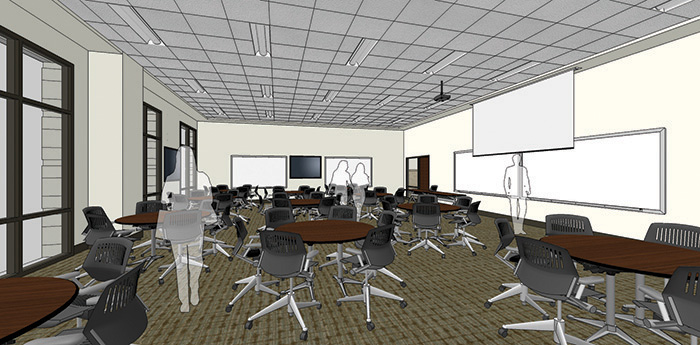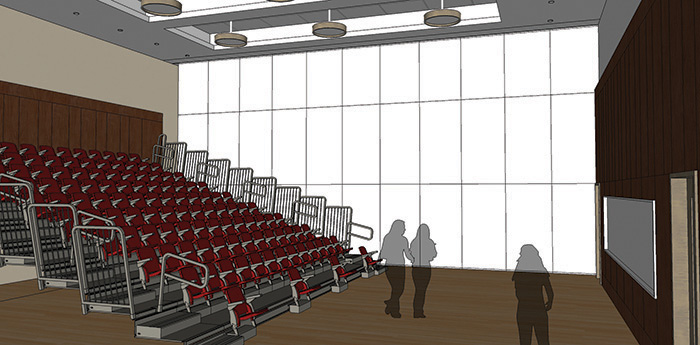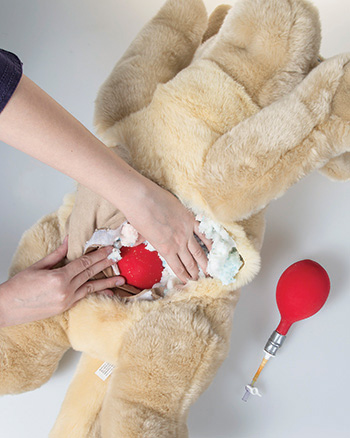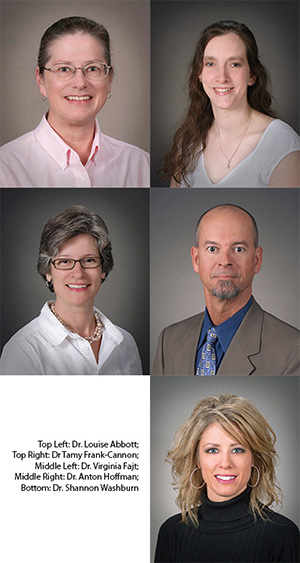Making Room for Transformative Teaching

When the Texas A&M College of Veterinary Medicine & Biomedical Sciences moves into its new complex in 2016, the space will be larger, modern, and full of light. More importantly, it will fundamentally change the way professors teach and students learn. The new facilities will foster learning rather than constraining it.
“We spend a lot of time and energy trying to work around our facilities right now,” said Dr. Shannon Washburn, who teaches physiology courses. “Now we’ll have the freedom to think how we can use our facilities instead of having to work around them.”
Washburn also mentioned that those little distractions that can impede learning-such as poor lighting and acoustics, unpredictable temperature, and uncomfortable seats-will all be greatly alleviated in the new building. “Every little thing that we can do to make learning easier for the students is good,” she said.
Classroom Layout and Space
The classrooms intended for lectures will each be large enough to comfortably accommodate a class of 250 people and their laptop computers which is especially important as more and more classes move to computerized testing.
The classrooms also will have a flexible layout. Several professors mentioned their excitement about this aspect. Dr. Virginia Fajt, who currently teaches a lecture-based pharmacology course in a classroom with stadium seating, said that the aisles keep students from interacting with each other and with her. In the new classrooms, she can arrange the seating without aisles-or in any other configuration that suits her.
Washburn agreed that it can be challenging to engage with students when teaching a large class in traditional lecture-style seats. “You’re standing up there talking,” she said. “We want to teach, not just talk.”
“The possibilities that exist in the new building include the option to include more collaborative and team-based approaches to teaching in a classroom,” Fajt continued. “The new building is going to really let us do that because some of the physical spaces are different from what we have now.”
Those physical spaces include collapsible seating in which the lecture-type seats can be folded up into the wall with the touch of a button. Chairs and tables can then be brought out of the adjoining closet and arranged in clusters for small group discussion, with room for the instructor to walk around and interact with each group. This sort of peer-topeer learning is extremely useful for helping students engage with the material and with each other. “And the more they engage, the better they learn,” Washburn said.
Fajt agreed that the new approaches help focus the educational process on the students themselves. “Instead of talking about teaching,” she sad, “we’re talking about learning.”
Lab Time and Space

Space for small groups to gather will be available during laboratory time as well.
“That will give the basic science instructors, myself included, the ability to do more small group discussion and more case studies, where it’s not practical to do it in the big laboratories right now,” said Dr. Anton Hoffman, who teaches anatomy. “It’s definitely preparatory for their transition into third and fourth year, where they’re always working in small groups as they’re on their rotations.”
The teaching laboratories themselves will be larger, with room for 100 students. This would allow for future growth for decades to come. Currently there are two lab sections, but the students in each section are in two adjoining rooms, and the instructor must run back and forth between them. The new building will have labs large enough for all of the students in a section to be together, which will allow for more student engagement with their classmates and interaction with the instructor.
For Dr. Tamy Frank-Cannon, who also teaches anatomy, a major advantage will be storage space. In the current building, she moves anatomic models into the laboratories to show the students and then moves them out again after the class or lab time is over. There is no designated space to store the items for the next time they’re needed. “We see what’s happened to my office here,” she said, gesturing to the models scattered on every spare surface of the room.
Dr. Louise Abbott, whose teaching includes large-animal gross anatomy, is also excited about the increased storage capacity. “What we currently have now is really haphazard,” she said. “We have stuff stored wherever we can fit it, and it’s often very inaccessible.”
The new building has storage and other support facilities built specifically for each major teaching lab. The storage
space will allow for more efficient use of class time. “Now the students have to go get their microscopes, bring them to the table, get them set up, get them plugged in, and get everything organized,” Hoffman said. In the new building, he said, the microscopes will be on a hidden rail system, so they can slide into place for use.
Using Models

In the new building, Frank-Cannon looks forward to more use of models on which students can practice clinical procedures. She currently is reengineering a stuffed animal for this purpose. “Right now, he’s just got stuffing and a fake bladder in him,” she said. “What I want to do is put in other organs, so that the students have to try to sort out what they’re feeling to make sure that they’ve actually got bladder before they actually shove the needle into them.”
Frank-Cannon uses different types of silicone to simulate muscles, bones, skin, and other organs. She said the process entails a good deal of trial and error as she tries to make each model anatomically correct. “There are a number of drafts involved, as you go step-by-step, trying to get the feel as close to the real thing as you can,” Frank-Cannon said. “For me, I take all of my anatomy skills and try to incorporate that into the models.”
“With the new building, one of the things that’s going to be really nice is dedicated space, or a space that’s really set up for this type of teaching,” Frank-Cannon continued. “Right now, we’re just making do with where we can find things to fit.”
Both Frank-Cannon and Abbott are excited about having a lab in the new building where they can make plastinated models. In these models, the tissue in specimens is replaced with polymers, resulting in long-lasting versions to use for study. “They get used after a number of years, and they eventually fall apart because the students handle them so much,” Abbott said. “We need to replace specimens, and we need to add specimens. That’s something that’s going to be very useful in this new building that we really don’t have the capability of doing right now.”
The new building will also allow students to study and practice on both plastinated and silicone models outside of class time, for which there isn’t currently space. “Right now, students have access when I bring them to use in teaching,”
Frank-Cannon said. “They don’t have access to practice or study or doing anything outside of class.” She said she hopes that in the dedicated space in the new building, the students can use the models outside of class time and perhaps even check them out to take home.
Abbott agreed that it would be extremely helpful for students to use the models outside of the official class or laboratory sessions. “I know in small animal [anatomy] they get a box of bones they can carry around with them, but they don’t have that capability in large animal because the bones are too big,” she said. “They have to actually do their studying from the specimens that are in the laboratory. Again, I think having good models they can take home will allow them a lot more flexibility for accessing information.”
Using Electronic Technology

Instructors are also excited about other planned technology in the new classrooms and labs. Better computers and
projection systems will allow for more multi-media use in lectures, which professors agree will facilitate demonstrating dynamic processes in real time. Some are also excited about the ability to expand digital testing capabilities, especially for laboratory portions of an exam.
Labs themselves will have more technology as well. “Right now in our current anatomy lab, if you need to make an announcement or talk to the students, you’re yelling,” Hoffman said. “There’s no microphone, there’s no PA.” The new labs, however, will have built-in sound systems. The labs will also have monitors scattered at the various workstations so that students can access information.
Those screens will also be able to project images from a mobile camera planned for the anatomy lab. “If we see something really awesome, it’s just going to be a matter of wheeling the camera over and saying to the students, ‘Hey, take a look at your monitors,’ and in two or three minutes, everybody gets it at the same time,” Hoffman continued. “It’s going to be a much more efficient use of laboratory time than it is now.”
Abbott looks forward to the anatomy labs’ having tablet computers on which students can consult dissection guides and access other information while they’re working with specimens. “I see that as sort of an adjunct to the computer screens that will be there,” she said.
Room to Dream
The professors also recognize that the space’s flexibility will give them options that they haven’t even considered yet, especially as they start to work in the new building and discover its capacities. “We’re now going to have the freedom to try new things,” Washburn said.
Fajt finds that the new building has served as an impetus for discussions among professors about new ideas and possibilities. “It’s on everyone’s mind, how we can improve,” she said.
Hoffman is excited about how he can put his teaching ideas into practice in the new building, without being confined by the physical space. “Being here 25-plus years, you get to the point where you get a little stifled,” Hoffman said. “In the new building, I think we’re going to be able to dream, to imagine new ways of doing things. It’s like I can do whatever I want now. I’m looking forward to it.”


